As it is large I can't dput it here. But suppose the realmatrix is a "mts" with non-trivial values
realmatrix <- matrix(NA, ncol = 100, nrow = 138)
In fact it stores 100 time series with length (rows) = 138 (from Jan 2005 to June 2016).
I want to store the Arima forecasts (12 months ahead: that is, from July 2016 to June 2017) in another matrix farimamatrix (which should have 12 rows and 100 columns), via the following loop:
farimamatrix <- matrix(NA, nrow = 12, ncol = 100)
m <- k <- list()
for (i in 1:100) {
try(m[[i]] <- Arima(realmatrix[,i], order = c(0,1,0), seasonal = c(1,0,1)))
k[[i]] <- forecast.Arima(m[[i]], h=12)
farimamatrix[,i] <- fitted(k[[i]])
}
But I am getting the following message:
Error in farimamatrix[, i] <- fitted(k[[i]]) :
incorrect number of subscripts on matrix
What's wrong? Thanks in advance.
Edited (24/10): updated / corrected under Zheyuan's answer and previous problem gone
Original data:
tsdata <-
structure(c(28220L, 27699L, 28445L, 29207L, 28482L, 28326L, 28322L,
28611L, 29187L, 29145L, 29288L, 29352L, 28881L, 29383L, 29898L,
29888L, 28925L, 29069L, 29114L, 29886L, 29917L, 30144L, 30531L,
30494L, 30700L, 30325L, 31313L, 32031L, 31383L, 30767L, 30500L,
31181L, 31736L, 32136L, 32654L, 32305L, 31856L, 31731L, 32119L,
31953L, 32300L, 31743L, 32150L, 33014L, 32964L, 33674L, 33410L,
31559L, 30667L, 30495L, 31978L, 32043L, 30945L, 30715L, 31325L,
32262L, 32717L, 33420L, 33617L, 34123L, 33362L, 33731L, 35118L,
35027L, 34298L, 34171L, 33851L, 34715L, 35184L, 35190L, 35079L,
35958L, 35875L, 35446L, 36352L, 36050L, 35567L, 35161L, 35419L,
36337L, 36967L, 36745L, 36370L, 36744L, 36303L, 36899L, 38621L,
37994L, 36809L, 36527L, 35916L, 37178L, 37661L, 37794L, 38642L,
37763L, 38367L, 38006L, 38442L, 38654L, 38345L, 37628L, 37698L,
38613L, 38525L, 39389L, 39920L, 39556L, 40280L, 41653L, 40269L,
39592L, 39100L, 37726L, 37867L, 38551L, 38895L, 40100L, 40950L,
39838L, 40643L, 40611L, 39611L, 39445L, 38059L, 37131L, 36697L,
37746L, 37733L, 39188L, 39127L, 38554L, 38219L, 38497L, 39165L,
40077L, 38370L, 37174L), .Dim = c(138L, 1L), .Dimnames = list(
NULL, "Data"), .Tsp = c(2005, 2016.41666666667, 12), class = "ts")
Code
library("forecast")
z <- stl(tsdata[, "Data"], s.window="periodic")
t <- z$time.series[,"trend"]
s <- z$time.series[,"seasonal"]
e <- z$time.series[,"remainder"]
# error matrix
ematrix <- matrix(rnorm(138 * 100, sd = 100), nrow = 138)
# generating a ts class error matrix
ematrixts <- ts(ematrix, start=c(2005,1), freq=12)
# combining the trend + season + error matrix into a real matrix
realmatrix <- t + s + ematrixts
# creating a (forecast) arima matrix
farimamatrix <- matrix(NA, ncol = 100, nrow = 12)
m <- k <- vector("list", length = 100)
for (i in 1:100) {
try(m[[i]] <- Arima(realmatrix[,i], order = c(0,1,0), seasonal = c(1,0,1)))
print(i)
k[[i]] <- forecast.Arima(m[[i]], h = 12)
farimamatrix[,i] <- k[[i]]$mean
}
# ts.plot(farimamatrix[,1:100],col = c(rep("gray",100),rep("red",1)))
The loop seems to work, but breaks down after a few iterations due to failure of Arima:
Error in stats::arima(x = x, order = order, seasonal = seasonal, include.mean = include.mean, : " non-stationary seasonal AR part from CSS


